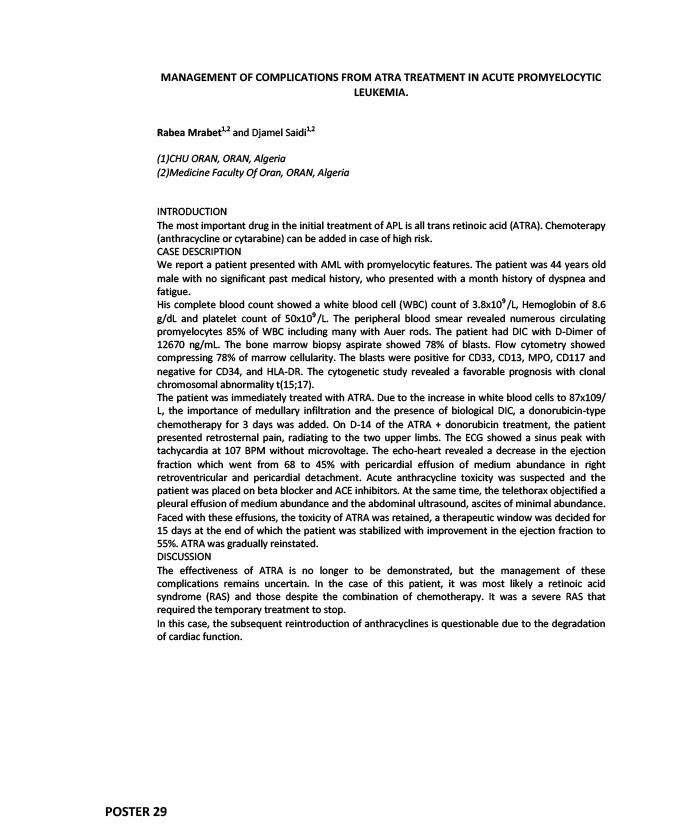
MANAGEMENT OF COMPLICATIONS FROM ATRA TREATMENT IN ACUTE PROMYELOCYTIC
POSTER 29
LEUKEMIA.
Rabea Mrabet1,2 and Djamel Saidi1,2
(1)CHU ORAN, ORAN, Algeria
(2)Medicine Faculty Of Oran, ORAN, Algeria
INTRODUCTION
The most important drug in the initial treatment of APL is all trans retinoic acid (ATRA). Chemoterapy
(anthracycline or cytarabine) can be added in case of high risk.
CASE DESCRIPTION
We report a patient presented with AML with promyelocytic features. The patient was 44 years old
male with no significant past medical history, who presented with a month history of dyspnea and
fatigue.
His complete blood count showed a white blood cell (WBC) count of 3.8x109 /L, Hemoglobin of 8.6
g/dL and platelet count of 50x109 /L. The peripheral blood smear revealed numerous circulating
promyelocytes 85% of WBC including many with Auer rods. The patient had DIC with D-Dimer of
12670 ng/mL. The bone marrow biopsy aspirate showed 78% of blasts. Flow cytometry showed
compressing 78% of marrow cellularity. The blasts were positive for CD33, CD13, MPO, CD117 and
negative for CD34, and HLA-DR. The cytogenetic study revealed a favorable prognosis with clonal
chromosomal abnormality t(15;17).
The patient was immediately treated with ATRA. Due to the increase in white blood cells to 87x109/
L, the importance of medullary infiltration and the presence of biological DIC, a donorubicin-type
chemotherapy for 3 days was added. On D-14 of the ATRA + donorubicin treatment, the patient
presented retrosternal pain, radiating to the two upper limbs. The ECG showed a sinus peak with
tachycardia at 107 BPM without microvoltage. The echo-heart revealed a decrease in the ejection
fraction which went from 68 to 45% with pericardial effusion of medium abundance in right
retroventricular and pericardial detachment. Acute anthracycline toxicity was suspected and the
patient was placed on beta blocker and ACE inhibitors. At the same time, the telethorax objectified a
pleural effusion of medium abundance and the abdominal ultrasound, ascites of minimal abundance.
Faced with these effusions, the toxicity of ATRA was retained, a therapeutic window was decided for
15 days at the end of which the patient was stabilized with improvement in the ejection fraction to
55%. ATRA was gradually reinstated.
DISCUSSION
The effectiveness of ATRA is no longer to be demonstrated, but the management of these
complications remains uncertain. In the case of this patient, it was most likely a retinoic acid
syndrome (RAS) and those despite the combination of chemotherapy. It was a severe RAS that
required the temporary treatment to stop.
In this case, the subsequent reintroduction of anthracyclines is questionable due to the degradation
of cardiac function.